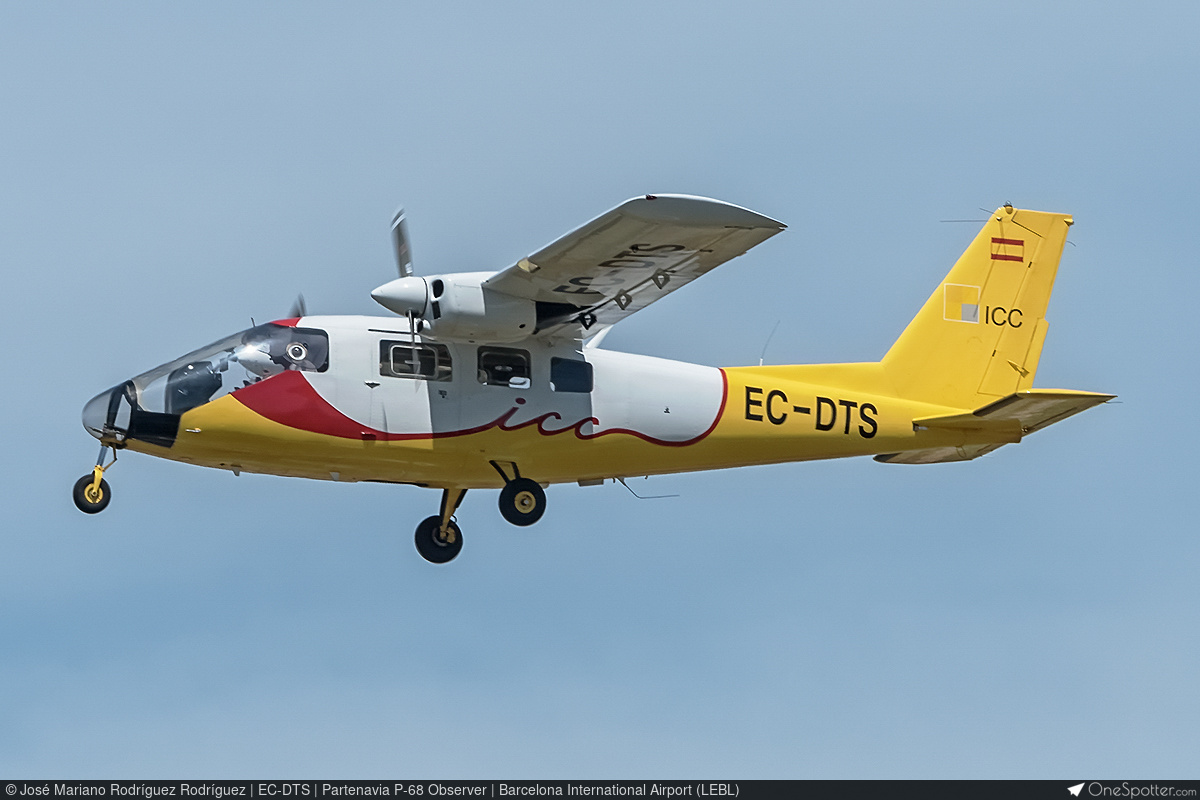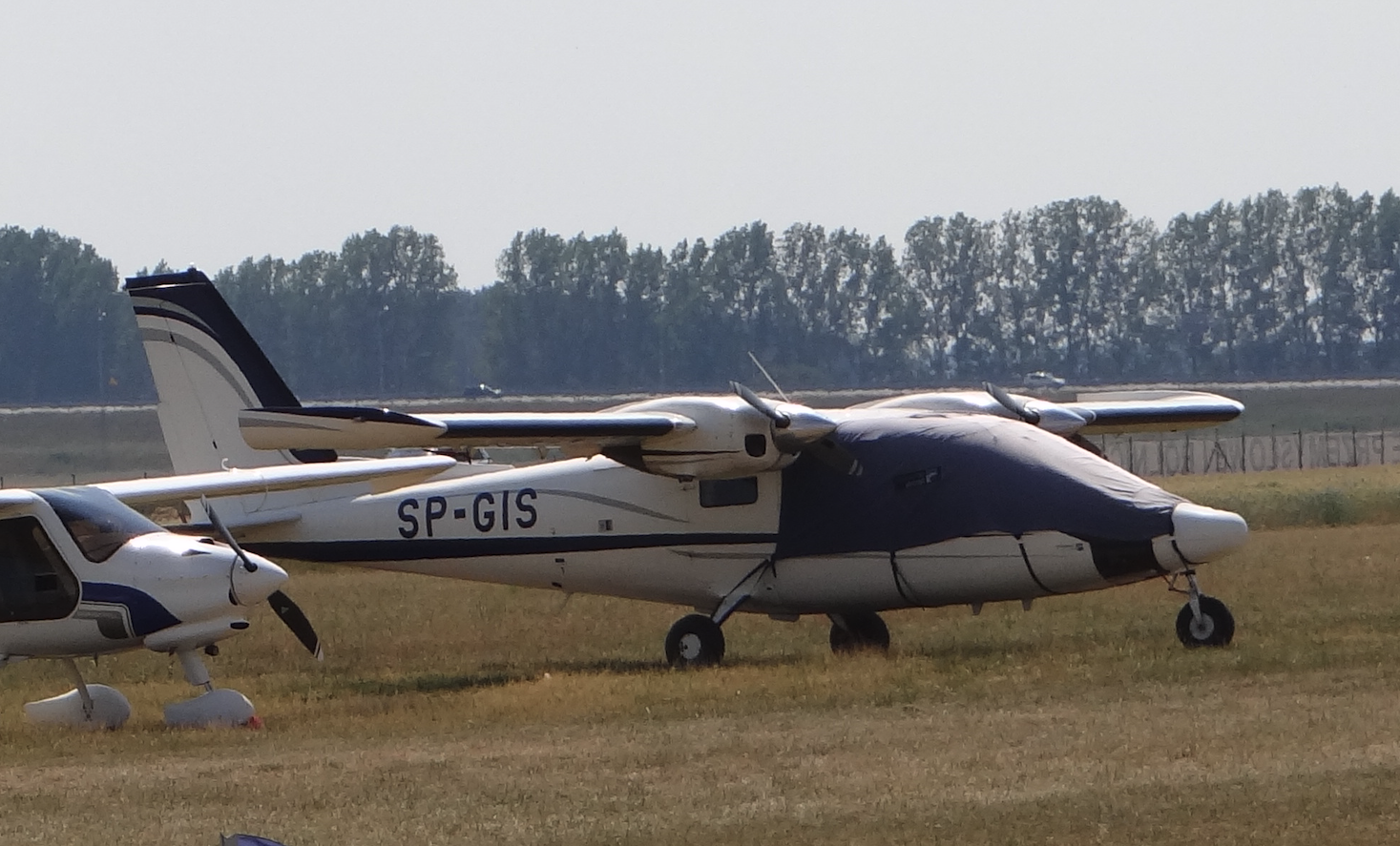P68 Aircraft - The Partavia P.68, now the Vulcanair P68, was a light aircraft designed by Luigi Pascale and originally built by Italy's Partavia. It made its first flight on 25 May 1970, was granted a type certificate on 17 November 1971 and was transferred to Vulcanair in 1998. The first six-seater aircraft was powered by two piston engines and used for light travel. and training. . The P.68 is a variant of the test aircraft, developed as an extension of the twin turboprop engine and 10/11 seats.
The type certificate for the P.68 Victor, a two-wing piston aircraft with a tricycle undercarriage, was filed on 22 January 1969.
P68 Aircraft

The Partavia P.68 was designed as a six-seat light transport and trainer with a 200 hp (149 kW) Lycoming IO-360 engine, and made its first flight on 25 May 1970 in Naples.
File:p68 Observer 2.jpg
Type certification for the 9.20m (30.18 ft) long P.68 was issued by the Italian Air Force on 17 November 1971 for an MTOW of 1,860 kg (4,100 lb).
After 300 hours of flight tests, it is planned to start in May 1972 in the new office at Naples' Capodichino airport at the rate of three flights per month.
The prototype was built in Arzan, Italy, production started with 14 aircraft before being delivered to the new factory in Casoria, Italy.
The long, 9.35 m (30.68 ft) P.68B certificate was applied for on 18 October 1973 and approved on 24 May 1974 for an MTOW of 1,960 kg (4,321 lb).
Vulcanair P68 Tc Observer
Both derived from the P.68B and measuring 9.55 m (31.33 ft) in length, the P.68R Victor had a retractable landing gear and was certified on 31 July 1978 while the P.68C had a nose-mounted weather radar. , with a larger fuel tank and increased weight, and was flown with an MTOW of 1,990 kg (4,387 lb) on 23 July 1979. The P.68C-TC, certified on 29 April 1980, had a 210 hp (157 kW) turbocharged Lycoming TIO- 360-C1A6D engines.
In 2021, the prepared price of the P.68C is US $ 1.19 million, US $ 1.22 million for the P.68R, and US $ 1.31 million for the P.68C-TC.
The 9.43 m (30.94 ft) long P.68 Observer, derived from the P.68B with a flexible nose fuselage, revised systems and larger fuel tanks, was certified on 12 June 1980.

P.68TC Observer of 9.15 m (30.02 ft) long, P.68 "Observer" with turbo engine, certified on 18 June 1985.
Vulcanair P68 Observer
The 9.54 m (31.30 ft) long P.68 "Observer 2" was a P.68 "Observer", with a heavier, turned wing and modified system, and was certified on 30 November 1989 for an MTOW of 2,084 kg (4594 lb ). .
10.89-11.27 m (35.73-36.97 ft) gear length retractable AP68TP-600 "Viator", with 328 hp (245 kW) Allison 250-B17C turboprops, weighing 2850-3020 kg on October 6140 , 1986. Year 2021 , its estimated cost is $3.154 million.
The 9.90 m (32.48 ft) gear AP68TP-300 Spartacus was certified on 10 December 1983 with twin Allison 250-B17C turboprops rated at 328 hp (245 kW) and 2,600 kg (MT)
Based in Casoria, Naples and part of Partavia, Vulcanair (th Air Samanta) bought a license type, spare parts aircraft and first production plant in Milan in April 1998 for L1.4 billion ($780,000).
Vulcanair P68 Retractable For Sale
P.68 was involved in 86 accidents and incidents worldwide, as reported in the Aviation Safety Network wiki database, including 58 lost aircraft.
11 September 1983: P.68C, N29561, performing air show, crashed in flight during Plainview, Texas Air Show. The NTSB report found that a review of the footage showed the plane had overshot the highway, exceeding its Vne (velocity, not to exceed) speed by 27 knots. The pilot made a sharp nose turn of about eight degrees, which increased the thrust of the aircraft to 8.3G and caused both wings to fall into the gap just ahead of the two engine nacelles separated from the plane, which began to turn, causing it to the back of the long curved basket between its house and its edge. The plane crashed 250 feet behind a group of spectators. Designed to provide an alternative and economical solution in a field where helicopters currently dominate.
Maximum 2 people (90kg) and 100kg payload: Long range, Cruise 55%, PWR 10000, 30' Res.

The new P.68TC Observer has a unique flight plan. In fact, the plane has a full Plexiglas nose that allows unlimited visibility.
Partenavia P68c For Sale
This unique feature has many benefits for many types of pilots/operators. Whether you're a law enforcement pilot or just want to enjoy the view, no other winged general aviation aircraft on the market has the same visibility.
You won't miss the road and you won't lose sight of the target on the ground. This is why the P.68TC Observer aircraft is the choice of many law enforcement agencies in the US and abroad.
This view shows the standard 1 + 5 seat interior layout of the P.68TC OBSERVER including the layout of the crew and cockpit, travel cabin and luggage and large rear cargo door and LH travel space route.
The plane can be equipped for 1 + 6 people by installing the back seat for three people in the back.
Police Recruiting Fixed Wing Pilots For Air Support Roles
An important new feature of the new generation P.68TC OBSERVER is the glass cockpit and adjustable avionics that includes the Garmin G1000 NXI along with the GFC700 digital autopilot which now has a yaw damper.
The new generation P.68TC OBSERVER has a redesigned interior. Thanks to the redesigned interior, passengers gained several inches of headroom, especially in the aft area.
The easily removable seats make the room great for transporting a variety of items, from mountain bikes or golf clubs to stretchers for air ambulance operations.

The P.68TC OBSERVER has a standard mount for the camera lens under the right second row seat. The camera housing is 2.1 ft long and 1.5 wide (63 x 46 cm) and allows for the installation of various equipment such as a professional digital digital camera and several gyro supported cameras such as L3 Wescam, Flir to name a few .
Vulcanair P68r D Gidk
The new P.68TC OBSERVER is equipped with two 210 HP Lycoming TIO-360-C1A6D four-cylinder engines. Hartzell constant speed drive, full propeller blades.
The extremely clean lines of the P.68TC OBSERVER are the result of many hours of wind tunnel testing and offer the best performance in terms of speed, rate of climb and endurance.
Let's not forget that the P68 series is designed and manufactured in Italy. Look at the clean lines of the plane and you will see the difference.
The P68 TC OBSERVER can be considered a flying SUV. The difference between this and any similar aircraft is that the P68 TC OBSERVER has two engines and these two engines are very powerful and reliable. No other lightweight twin on the market offers three rows of removable seats, more than 65 cubic feet of interior volume including 20 cubic feet of cargo space that allows for a maximum payload of 400 lbs.
Partenavia P68 By Darthpandanl On Deviantart
The flexibility of the P.68TC OBSERVER allows the pilot to fly the aircraft in many ways that can meet many different mission profiles.
* It is the pilot's responsibility to perform all operations in accordance with the approved pilot's manual, which is the sole source of information.
The painstaking work of a good designer/tester really did result in some very nice features, especially at low speeds or in the unlikely event of engine failure. The forward position of the pilot in relation to the wing allows visibility backwards and forwards, which ensures greater safety in crowded skies. With the optional de-icing equipment installed on the P.68TC, the OBSERVER operates around the clock in safety and at all times, from the harsh winter conditions across the North Sea and across northern Europe to the environment strong in Africa and Australia.
The P68 system has one characteristic, economy. The economy of the aircraft is due to the low cost and low labor costs, which is a direct result of the ease of building the aircraft with less fuel and replacement costs of its power plant. A robust chassis that does not require maintenance, a fixed chassis with leaf springs, no complicated systems and an unparalleled access to the work area reduces maintenance to a minimum. The high wing design allows the engine and propeller tips to be kept on the ground, reducing drag on rocks and increasing the engine's lift.
Vulcanair P68 Private Jet Hire
Although it is true that aircraft components do not have rivets, we believe that there are many advantages to aluminum construction. The first advantage is the weight compared to a similar system that is made of aircraft-supported components. Another factor is the well-known and well-documented aging and fatigue of aluminum construction and the ease of repair. Derived from the successful Partenavia P.68 series, the P.68 Observer series is a six-seat, twin-engine, high-wing, landing gear aircraft for observation, light travel and air taxi.
The main part of the aircraft is the excellent helicopter-like visibility, achieved by making the entire fuselage in Plexiglas. This one
P68, harman pellet stove p68 price, compressor oil p68, harman p68 control board, harman pellet stove p68, traser p68 pathfinder, harman p68, p68 aircraft for sale, harman p68 pellet stove parts, harman p68 parts, harman p68 for sale, p68 pellet stove

0 Comments